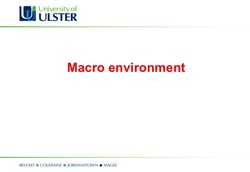
10
The second section of the element in the workshop begins with some consideration of how entrepreneurship and business ideas generation operate within the changing environment where organisations carry out their various activities – the macro environment.
The second section of the element in the workshop begins with some consideration of how entrepreneurship and business ideas generation operate within the changing environment where organisations carry out their various activities – the macro environment.
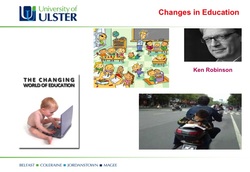
11
We then go on to look at how the world of education has been challenged and is in need of change as we move further into the 21st-century.
Sir Ken Robinson's TED session and RSA Animate indicate some of the significant issues where changing demographics, new technologies and an awareness of different learning styles and preferences challenge some of the paradigms used in teaching and education in the last two centuries.
We then go on to look at how the world of education has been challenged and is in need of change as we move further into the 21st-century.
Sir Ken Robinson's TED session and RSA Animate indicate some of the significant issues where changing demographics, new technologies and an awareness of different learning styles and preferences challenge some of the paradigms used in teaching and education in the last two centuries.
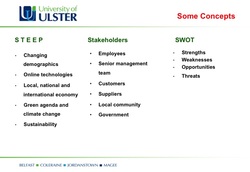
12
This slide provides an opportunity to recapitulate some analytical techniques that probably be familiar to everyone but nevertheless have considerable value;
This slide provides an opportunity to recapitulate some analytical techniques that probably be familiar to everyone but nevertheless have considerable value;
- STEEP analysis (or STEP analysis or PEST analysis)
- Stakeholder analysis
- SWOT analysis
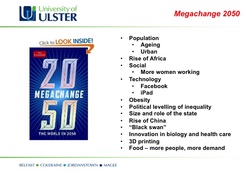
13
This slide introduces some of the factors that have been identified by journalists working for The Economist as a source of significant impact on the organisations in decades to come.
Watch it again here.
This slide introduces some of the factors that have been identified by journalists working for The Economist as a source of significant impact on the organisations in decades to come.
Watch it again here.
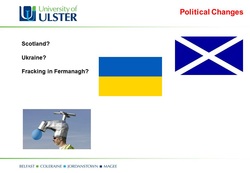
14
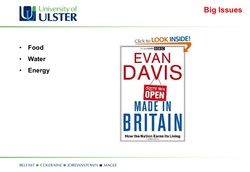
15
I make brief mention of Evan Davis, the BBC journalist and presenter of Dragon’s Den, who identifies food, water and energy as three of the big issues that are likely to have an impact in the medium and long term future.
I make brief mention of Evan Davis, the BBC journalist and presenter of Dragon’s Den, who identifies food, water and energy as three of the big issues that are likely to have an impact in the medium and long term future.
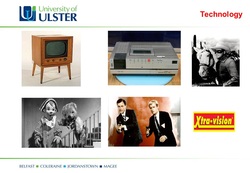
16
I deal briefly with some of the changes that are identified in the various points included on this slide, with some examples drawn from my own experiences growing up in the 1950s and 1960s.
For example, in my childhood much seemed to be grey or black and white: newspapers and comics were black and white, TV (when it arrived) was black and white and clothing tended to be dark and lacking in colour.
As the 1960s took hold, much of the environment became a lot more colourful.
I deal briefly with some of the changes that are identified in the various points included on this slide, with some examples drawn from my own experiences growing up in the 1950s and 1960s.
For example, in my childhood much seemed to be grey or black and white: newspapers and comics were black and white, TV (when it arrived) was black and white and clothing tended to be dark and lacking in colour.
As the 1960s took hold, much of the environment became a lot more colourful.
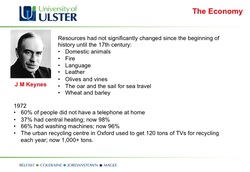
17
John Maynard Keynes made the observations at the top of the slide.
Even 40 years ago much that we take for granted was in the early stages of adoption in a consumer society.
John Maynard Keynes made the observations at the top of the slide.
Even 40 years ago much that we take for granted was in the early stages of adoption in a consumer society.
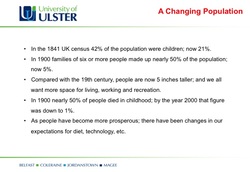
18
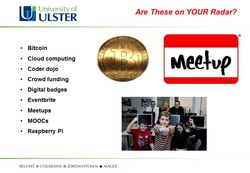
19
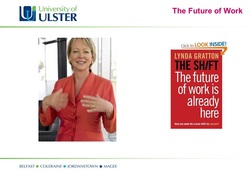
20
I make linkages to the work students have recently completed on The Future of Work and the ideas of Lynda Gratton and some of the changes in the workplace that will require entrepreneurial responses from those who have management roles in organisations.
You may find the 32 issues worth consideration.
I make linkages to the work students have recently completed on The Future of Work and the ideas of Lynda Gratton and some of the changes in the workplace that will require entrepreneurial responses from those who have management roles in organisations.
You may find the 32 issues worth consideration.

Over to you
The purpose of this section is to give you an opportunity to identify some significant factors in the wider environment which are likely to have an impact on the organisation on which you focus your assignment and any opportunities for innovation and entrepreneurship in practice that can be applied there.
The purpose of this section is to give you an opportunity to identify some significant factors in the wider environment which are likely to have an impact on the organisation on which you focus your assignment and any opportunities for innovation and entrepreneurship in practice that can be applied there.
